Start Licensing’s Ian Downes has his view reinforced this week that when used in a focused way licensing is a very flexible and adaptable business model.
Value retailing and value retailers are now a valued part of the licensing landscape. A few years ago there may have been some internal debate within rights owners and agents as to whether value was a sector that they wanted to engage with, but I would hazard a guess that isn’t up for debate these days. It’s a case of when, not if.
Retailers like Home Bargains, B&M and Poundland have shown that the value model works and that licensing can play a part in their retail offering. Of course, the overall retail landscape has changed and the value retailers have adapted their approach over the years – for example Poundland sells goods at different prices these days above and beyond a pound. Suppliers have got into the routine of creating specific products and packs for the sector while ‘popping into Poundland’ or ‘bagging a bargain at Home Bargains’ is second nature for consumers.
I actually ‘popped into Poundland’ myself this week, partly seeking out a few items for a forthcoming business trip, but also to check out the latest licensing plays in-store. Overall it was clear that licensed products are very much part of the Poundland economy and that a broad spectrum of brand owners are happy to be part of the licensing mix there. Licensing plays a part in a number of categories in-store.
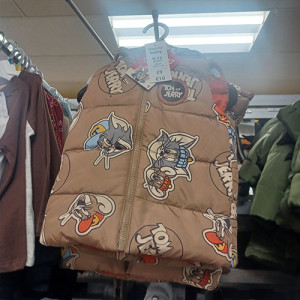 Apparel is now a core part of the Poundland offer and in turn licensing is a key part of the apparel offering. Disney features with classic characters such as Minnie Mouse and Mickey Mouse. This runs across adult and children’s. Some thought has gone into design with classic poses, contemporary colour ways and repeat patterns in play.
Apparel is now a core part of the Poundland offer and in turn licensing is a key part of the apparel offering. Disney features with classic characters such as Minnie Mouse and Mickey Mouse. This runs across adult and children’s. Some thought has gone into design with classic poses, contemporary colour ways and repeat patterns in play.
Design wise it seems that Poundland approaches things like other retailers in regard to trying to be on trend and to reflect current design needs while establishing its own ‘look’. It seems that for some brand owners Poundland offers an opportunity to showcase classic characters from their portfolios – for example The Flintstones had a number of lines in-store, as did Tom & Jerry.
This is a great way for classic brands to get traction and for fresh design work to be showcased.
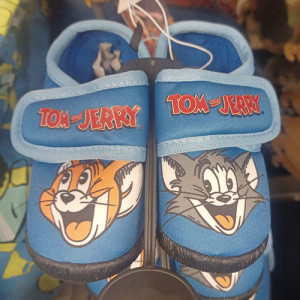 For Poundland, working with classic brands probably suits it and is similar to how it works with well established FMCG brands – aligning itself with brands that consumers know and trust. It is also character brands that work well as gift or pick up items – you can imagine grandparents buying some of these apparel lines at Poundland for their grandchildren, not least as they are characters the grandparents recognise. It was encouraging to see some thoughtful design touches like Tom & Jerry being used on footwear as a ‘pair’ with one character featuring on a single shoe of the pair. Other featured characters in the apparel department included Batman, Gremlins and Chip’n’Dale. There was also a nice mix of items such as gilets, fleece tops and nightwear.
For Poundland, working with classic brands probably suits it and is similar to how it works with well established FMCG brands – aligning itself with brands that consumers know and trust. It is also character brands that work well as gift or pick up items – you can imagine grandparents buying some of these apparel lines at Poundland for their grandchildren, not least as they are characters the grandparents recognise. It was encouraging to see some thoughtful design touches like Tom & Jerry being used on footwear as a ‘pair’ with one character featuring on a single shoe of the pair. Other featured characters in the apparel department included Batman, Gremlins and Chip’n’Dale. There was also a nice mix of items such as gilets, fleece tops and nightwear.
Another strong play for licensing in Poundland was in the greeting cards section. Within a busy feature there was a good presence for Disney characters. Again, these are safe bets as consumers recognise them and, of course, Disney can offer a variety of characters. But it is also important to remember categories like cards need a lot of creative resource to help support a range and, as noted in previous Lookouts, brand owners are investing in design packs to support specific categories and also to offer specific retail channels their own bespoke look. Of course, in this regard brand owners like Disney have design rich archives.
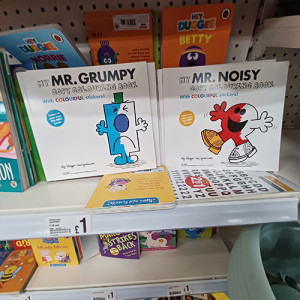 Poundland also seems adept at product sourcing. I imagine it’s buyers scouring the market for new suppliers including overseas ones. I also imagine it works with its supplier base to create specific formats that suit in categories like publishing. A good example of it casting the sourcing net wide was a range of Smurfs colouring books sourced from a European publisher, while there were some other arts and crafts formats featuring the likes of Mr Men and Batman that seemed to be tailored made to fit the Poundland model.
Poundland also seems adept at product sourcing. I imagine it’s buyers scouring the market for new suppliers including overseas ones. I also imagine it works with its supplier base to create specific formats that suit in categories like publishing. A good example of it casting the sourcing net wide was a range of Smurfs colouring books sourced from a European publisher, while there were some other arts and crafts formats featuring the likes of Mr Men and Batman that seemed to be tailored made to fit the Poundland model.
Beyond Poundland, another thing I have picked up on this week is how retailers seem increasingly tuned into ‘annual’ calendar events that allow them to focus on specific products and offers often using FSDUs, window posters and in-store marketing to shine a light on the opportunity.
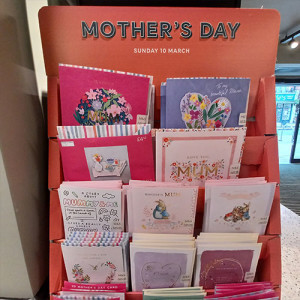 Mother’s Day is a good example of this and I have seen several retailers running FSDU programmes showcasing greetings cards – for example Poundland had one.
Mother’s Day is a good example of this and I have seen several retailers running FSDU programmes showcasing greetings cards – for example Poundland had one.
I have also seen Mother’s Day FSDUs in Marks & Spencer, Sainsbury’s and Waitrose. No excuses for me… I have got my mum a card (I’m actually sending her one from Woodmansterne’s Nadiya Hussain card range – lovely cards but also nice to support one of your own ranges).
Interestingly licensing features in some of these FSDU programmes – for example I saw a couple of charming Peter Rabbit cards in the Marks & Spencer FSDU. Again the artwork has been well chosen to fit the occasion, while Emma Bridgewater featured in the Waitrose FSDU, as did Quentin Blake.
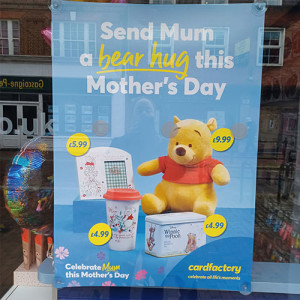 Card Factory is also embracing Mother’s Day and using licensing as part of its offer for the occasion. Winnie the Pooh featured on window posters at the retailer with the slogan ‘Send Mum a Bear Hug this Mother’s Day’. It had curated a collection of products including a tea gift tin, plush and a photo frame. A good use of a much loved character, but also one that has a premium feel to it, plus Winnie the Pooh has the ability to work on a range of products. Of course, Card Factory is also a value driven retailer and this range is competitively priced. It is an attractive and convenient offer making good use of a classic character brand. A great case study of licensing at retail.
Card Factory is also embracing Mother’s Day and using licensing as part of its offer for the occasion. Winnie the Pooh featured on window posters at the retailer with the slogan ‘Send Mum a Bear Hug this Mother’s Day’. It had curated a collection of products including a tea gift tin, plush and a photo frame. A good use of a much loved character, but also one that has a premium feel to it, plus Winnie the Pooh has the ability to work on a range of products. Of course, Card Factory is also a value driven retailer and this range is competitively priced. It is an attractive and convenient offer making good use of a classic character brand. A great case study of licensing at retail.
Easter is also a season that is starting to show up at retail and again licensing is playing its part. I noticed a range of Kinder ‘flame’ eggs featuring Frozen and Hot Wheels in Waitrose. The Kinder format includes a surprise toy. In this context brands like Hot Wheels work very well. Again, it seems to be that brand trust and awareness is a key to success in the context of products like this. They are gift purchases and as such the purchaser has to be familiar with the brand while the product has to represent good value. From the brand owners perspective, working with companies like Kinder helps give the licensed brand further authority, but also opens up broader distribution retail and territory wise. It is a good partnership for both players.
My Looking Out this week has reinforced my view that when used in a focused way licensing is a very flexible and adaptable business model. It brings value with it, but it has to be deployed with care and focus. Increasingly I think we have to be tuned into consumers and what is driving their purchase decisions. Value is one factor, as is a desire to support brands they trust. Hopefully my mum doesn’t read the Licensing Lookout and I can surprise her with the Mother’s Day card I have chosen for her!
Ian Downes runs Start Licensing, an independent brand licensing agency. His Twitter handle is @startlicensing – he would welcome your suggestions for what to look out for.




























